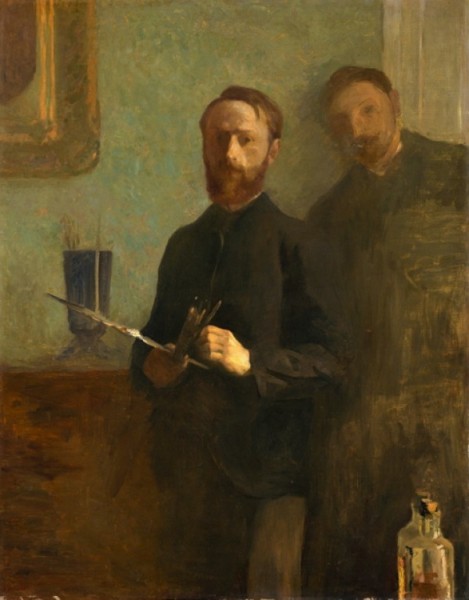
Edouard Vuillard, “Self-Portrait with Waroquy,” oil on canvas, 1889 (The Metropolitan Museum of Art, New York, Gift of Alex M. Lewyt, 1955, 55.173)
The Jewish Museum
1109 Fifth Ave. at 92nd St.
Thursday – Tuesday through September 23, $12 (free admission Saturday 11:00 am – 5:45 pm)
212-423-3200
www.thejewishmuseum.org
Throughout his career, Edouard Vuillard surrounded himself with people in the art world, from patrons, gallerists, and publishers to poets, musicians, and other artists, men and women who ultimately populated so many of his canvases. A member of the avant-garde Nabis (“prophets” in Hebrew), which also included Pierre Bonnard, Maurice Denis, Aristide Maillol, and Félix Vallotton, the French painter immersed himself in the emerging Parisian cultural scene, attending salons, designing theater programs, and getting involved in photography. Divided into six sections — “Son, Artist, Prophet,” “The Muse and the Review,” “New Patrons and a New Muse,” “Decorative Murals,” “Later Portraits,” and “The Chateau des Clayes” — the exhibition follows Vuillard’s personal and artistic development in paintings, photographs, books, magazines, and a short home movie as he established an affinity for portraiture and interiors filled with delightful patterns and texture. A key early work, “Self-Portrait with Waroquy,” shows the artist, palette in hand, looking into a mirror, a ghostly apparition of a friend standing over his shoulder, done in earth tones, a bottle in the right foreground almost demanding to be grabbed. But Vuillard spent much more of his time painting others and not himself, displaying his impressive social circle and those who were part of his daily life, concentrating on such figures as his mother, Thadée and Misia Natanson, Jos and Lucy Hessel, and the Bloch family. In “Madame Vuillard at Table,” the artist’s square-shouldered mother is smiling in the back right of the frame, a large bottle battling for attention in the left foreground. In “Thadée Natanson at His Desk,” the subject nearly disappears into the scene. And in “Lucy Hessel at the Seashore,” Lucy is shown lounging front and center, amid brighter though still subdued colors, looking lovingly at the viewer but also at the artist; the two were extremely close for decades. “That idea of the sea and the pink tonalities conspire to give you this idea of love, Vuillard’s confession of love for Lucy Hessel,” assistant curator Stephen Brown says on the exhibition’s Acoustiguide tour. “I don’t think there can be any question that they were lovers and it went on for some forty years.” Vuillard spent much of his later years at Chateau des Clayes, the Hessels’ estate near Versailles, where he painted one of his masterpieces, “Luncheon at Les Clayes.” Using glue-based distemper and charcoal, he depicts a group of figures at one end of a round table, centered by Lucy and also including his mother, with bottles and mirrors, subjects that appear consistently throughout his work, a fine representation of his overall themes and style encapsulated in one gorgeous interior. “Edouard Vuillard: A Painter and His Muses, 1890-1940” is a fascinating examination of the life and work of a lesser-known but important artist who is well worth another look.